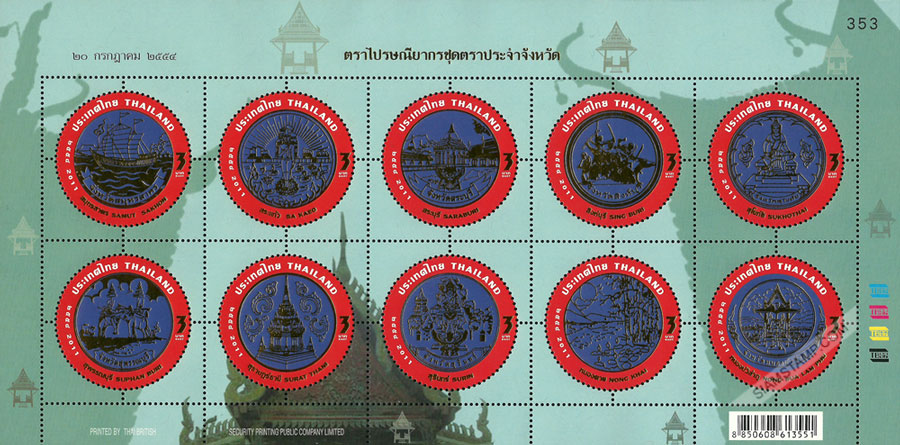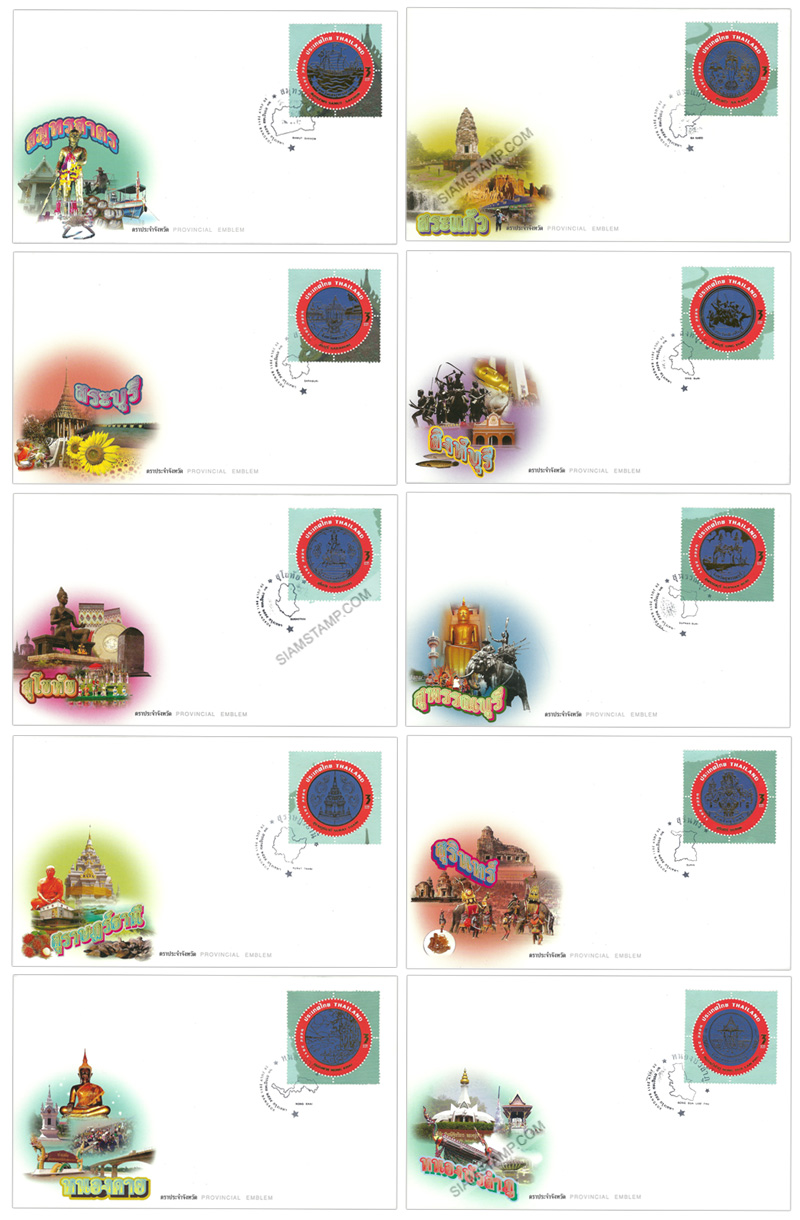| Details :
|
Local Identity
This issue is the 6th releasing time of a Provincial Emblem set, but it is the sheet number seven, because the first issue has released 2 sheets (20 Provinces). And in the next time issue, it is the final sheet, completely of the Provincial Emblem set, because Thailand has now 77 provinces.
This issue has the emblem of 10 provinces are following:
- 1. Samut Sakhon: The emblem depicts a Chinese junk at sea, sailing againt a background of factories and a smoking chimney signifying the Province's prosperity form past to present. Samut Sakhon's provincial emblem was first introduced in 1940 at the time when Luang Wisetpakdi (Chuen Wisetpakdi) was the governer.
- 2. Sa Kaeo: The emblem is a depiction of a pond with lotus flowers against a background of the rising sun. At the center of the emblem is a picture of the Province's major archaeological site of Prasart Khao Noi (in pink color) while in the foreground is the picture of a standing Buddha image on a large lotus flower. This Buddha image is especially built for Sa Kaeo Province to become the focal point of its resident's faith and unity. The emblem signifies Sa Kaeo's tranquility and abundant water supply.
- 3. Saraburi: The emblem is a depiction of a Mandop (a square hall with pyramidal roof) in Tambon Khun Khlon of Phra Bhuddabart District built over the sacred footprint of the Lord Buddha. which is highly revered by the Thai people.
- 4. Sing Buri: The emblem depicts the sculptures of 11 Thai heroes of the old days of Bang Ra Chan Village against a background of a red, round shield with white, blue and red circles on the rim. Underneath the sculpture are the words Sing Buri Province written along the curve of the shield.
- 5. Sukhothai: The emblem is depiction of King Ramkhamhaeng the Great, a king of Phra Ruang Dynasty, sitting on the stone Manangkhasila bench. The King was famous for his golden reign which brought peace and prosperity to the ancient Thai kingdom, Sukhothai Period.
- 6. Suphan Buri: The emblem is a depiction of King Naresuan the Great who, in 1592, fought against the Crown Prince of Burma on elephant backs and won the fight. This battle freed Thailand from Burma's rule and brought great fame to King Naresuan. It is believed that this famous combat on elephant backs took place in Don Chedi District of Suphan Buri Province.
- 7. Surat Thani: The emblem is a depiction of the Great Stupa of Chaiya which is believed to house some of Buddha's relics. It is one of the most important Buddist memorials in Thailand.
- 8. Surin: The emblem is a depiction of the Hindu God Indra sitting crossed-legged in a lotus style on a bench, which has a figurine head of Erawan Elephant on the bench's center. Indra is holding a short trident in his right hand and mahout's hook in his left hand. A picture of Prasart Sikoraphum (previously known a Prasart Ra-ngaeng) is depicted in the background and a Garuda flag appears in the foreground
- 9. Nong Khai: The emblem is a depiction of a pond, a cluster of bamboo plants and lotus flowers. The history behind this depiction dates back to the time when King Rama III ordered Phraya Rajasupawadi to lead a Siamese army to reclaim the city of Srisatanakanahoot from the enemy. After the task was accomplished Phraya Rajasupawadi let Thao Suwor select a location to establish a new town in the area. Thao Suwor chose an area around a large pond called Nong Khai in Ban Phai District where bamboos were found in abundance.
- 10. Nong Bua Lam Phu: The emblem is a depiction of King Naresuan the Great standing with a sword in his left hand and infront of a pavillion located on the edge of a lotus pond.
Quantity of stamps: 300,000 pieces (200,000 pieces for different-design sheets; 100,000 pieces for same-design sheets)
Composition: 10 stamps per sheet
Printing Process: Lithography with special technique (Gold metalic hot foil stamp)
Designer: Udon Niyonthum (Thailand Post Co., Ltd.)
FDC Price: 102 Baht (Salable at a set of 10 covers)
Quantity of FDC: 1X,000 covers each |






